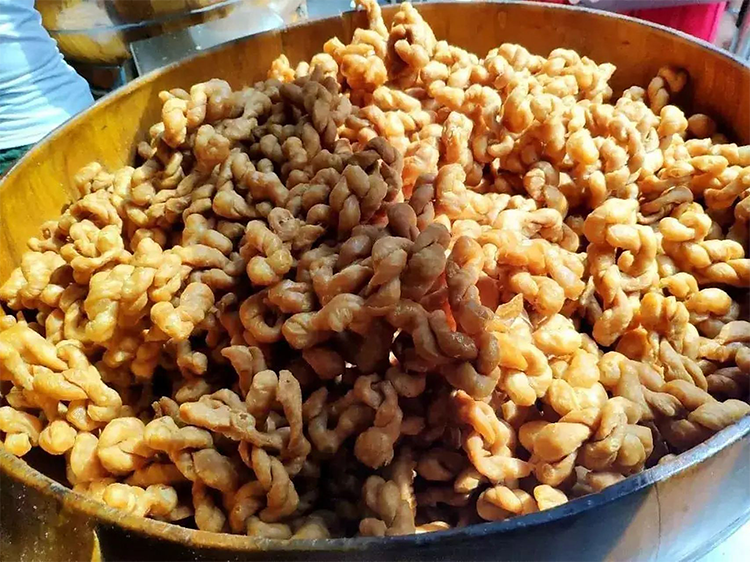Ningbo Oil Zanzi: Century-Old Crispy Twist
Introduction
Stroll through Ningbo’s old lanes and you’ll hear soft Wu dialect while a tempting salty, fried aroma leads you to a tiny shop. There, golden Ningbo Oil Zanzi (yóu zànzi) come straight from the oil, crisp and warm. More than a fried twist, this snack preserves over a century of local memory and flavor. This article unlocks the history, ingredients, craft, and tasting tips for Ningbo’s most authentic street treat.
1. Origin and History: A Qing Dynasty Street Snack
Ningbo Oil Zanzi traces its roots to the Guangxu years of the Qing Dynasty. In a time before modern snack factories, local pastry chefs adapted northern mahua techniques and infused them with Ningbo character to create the oil zanzi. In Ningbo dialect, “zanzi” affectionately refers to a mahua-style twist; the name itself reflects local admiration for the snack. Passed down for generations, the purely handmade craft has kept each piece rich with the warmth and skill of its makers, making it a representative traditional food of Ningbo.
2. Cultural Significance: Ningbo’s ‘Leisure Food’ Philosophy
In Ningbo, oil zanzi is more than food—it’s culture and comfort. Classified locally as a “guozi” (dialect snack), it’s a staple during tea breaks, casual visits, and social gatherings. A plate of oil zanzi quickly creates a relaxed atmosphere and helps guests feel at home. Its claimed stomach-soothing and digestion-aiding properties reflect Chinese food-medicine wisdom: pleasure combined with care. For many expatriates and visitors from Ningbo, the flavor equals home—a comforting reminder of roots.

3. Ingredients: Simple Components, Distinct Character
The charm of oil zanzi comes from carefully selected, straightforward ingredients. High-quality wheat flour forms the base for a crisp, sturdy texture after frying. Seasoning is intentionally simple: refined salt, rock sugar (for sweet versions), and refined vegetable oil. The standout variety is the seaweed (nori) salted oil zanzi, which blends natural seaweed powder into the dough, giving a subtle green hue and a briny, ocean-like umami that contrasts the classic sweet version. All raw materials emphasize natural, green-sourced ingredients to preserve purity and healthfulness.
4. Making Method: Traditional Craft at the Fingertips
Eating oil zanzi is largely appreciating artisanal handwork. The process resists mass production: masters knead the dough, let it rest, then roll it into strips. With practiced feel, they twist two strands like a braid to form the signature spiral. That single twist defines the layered crispiness. The pieces fry in meticulously controlled oil temperature until golden. Timing and heat are crucial—too long yields bitterness, too short yields sogginess. This devotion to craft gives oil zanzi its irreplaceable crunch.

5. Flavor and Texture: An Irresistible Crispy Symphony
Fresh from the fryer is when oil zanzi sings. Sweet versions present golden color, the clean sweetness of rock sugar, and a rich roasted wheat aroma. A bite produces a crisp “crack” and a lingering fragrance. The seaweed salted variety delivers a bold first note: ocean umami and mild saltiness, followed by the flaky wheat crunch—savory without greasiness. Both styles share the addicting crunchy texture that makes it impossible to stop after one piece.
6. How to Eat: Best Serving Suggestions
The prime way to enjoy oil zanzi is fresh and warm—buy-and-eat on the spot for the ultimate crunch. It’s also a perfect tea-time companion: a cup of clear tea balances any fried richness. For first-time visitors, opt for a “sweet-and-salt combo” to sample both classic and seaweed flavors. Sealed packages also make practical souvenirs; properly packed oil zanzi keeps well for gifting.

7. Where to Find Authentic Oil Zanzi in Ningbo
To taste the most authentic oil zanzi, head to Ningbo’s old city—areas like Gulou and Nantang Old Street feature long-standing shops. Queues often indicate quality; look for evenly golden, glossy twists of uniform thickness. Buying fresh out of the fryer is ideal, and local shop owners usually enjoy sharing stories about their recipe heritage. Packaged zanzi from established stores makes an excellent edible gift.
8. Easy Home Recipe: Recreate Ningbo Flavor
While it’s hard to match a master’s technique, you can make a simple home version. Ingredients: 250g all-purpose flour, 1 egg, about 80ml water, sugar (or salt and seaweed powder), and vegetable oil for dough and frying. Steps: 1) Mix flour, egg, water, and sugar (or salt) into a smooth dough; rest 30 minutes. 2) Roll into a sheet and cut even strips. 3) Twist pairs of strips together and pinch ends. 4) Heat oil to about 160°C (six-tenths hot); fry over medium-low heat until golden and floating. Drain and cool. Homemade zanzi may be imperfect in shape, but fresh warmth and crunch deliver plenty of satisfaction.

Conclusion
This small twisted pastry condenses Ningbo’s culinary wisdom and everyday joy. Ningbo Oil Zanzi is more than a snack—it’s a fragrant city emblem. On your next visit to this seaside city, follow the tempting crisp scent and taste a century-old treat. That satisfying “crack” may become one of your most vivid Ningbo memories.
This article was written by a Senior China Travel and Food Planner, intended to provide a unique culinary perspective for your China trip.


